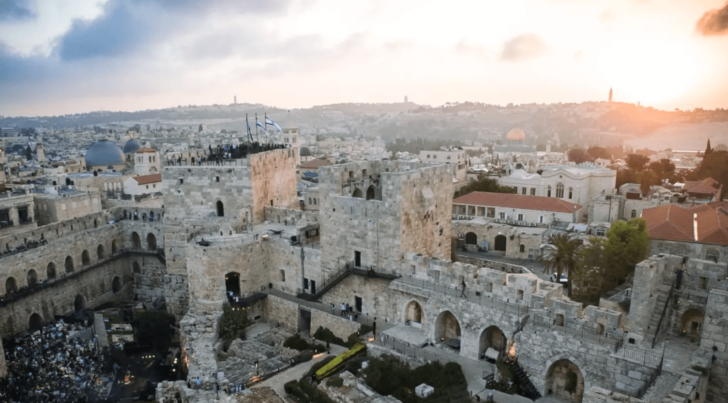At the opening of the American embassy in Jerusalem on May 14, 2018, Prime Minister Benjamin Netanyahu repeated his government’s view that Jerusalem is the “eternal, undivided capital of Israel.”
Jerusalem has existed for over 7,000 years. Jews have been unquestionably connected with the city for 3,000 or so – yet it functioned as their capital only for short periods in history.
By Philippe Bohstrom, Ha’aretz
“May the opening of this embassy, in this city, spread the truth far and wide and may the truth advance a lasting peace between Israel and all our neighbors. God bless the United States of America, and God bless Jerusalem, the eternal, undivided capital of Israel.” – Prime Minister Benjamin Netanyahu, at the inauguration of the U.S. embassy in Jerusalem, May 14, 2018
Actually, five months before, Netanyahu said (also on YouTube) that Jerusalem had been Israel’s capital for about 3,000 years, which isn’t accurate either.
About 4,000 years ago, Canaan was thinly populated. Here and there were fortified cities amidst the ploughed fields. The people lived in a state of constant readiness for sudden attack by desert nomads: the settled farmers and the hordes who had no fixed home, living in goat-hair tents under the open desert skies, were in constant conflict.
This was the restless land into which Abraham made his way with his family, kinsfolk and flocks, according to Jewish and Muslim traditions. One of the towns Abraham visited was “Salem,” led by Melchizedek the priest-king (Genesis 14:18).
In the 1920s, remarkable pottery sherds were found by the Nile, chiefly at Thebes and Saqqara. Many were inscribed with curses, such as, “Death strike you at every wicked word and thought, every plot, angry quarrel and plan”.
These unpleasant wishes were addressed to high-ranking officials in Egypt, and also in Canaan and Syria. It was believed that at the moment the vase was smashed, the power of the cursed party would be broken. Commonly, the spell would specify the family, relatives, and even the hometown of the accursed. Some of these magical texts include the name Salem, today better known as Jerusalem.
Jerusalem has existed for over 7,000 years: prehistoric stone houses and artifacts were discovered in the city’s north, in 2016. However, organized settlement in “Salem” dates to the Middle Bronze Age, 4,000 to 3,750 years ago. A couple of hundred years later, by the 19th and 18th century B.C.E., official Egyptian records were describing Salem as a ruling city in the central hill country.
It would remain prominent for centuries. Letters from Salem’s ruler, Abdi-Hepa, to the Egyptian pharaoh Amenhotep (1350-1334 B.C.E.) indicate that it was a major Canaanite hub in the Levant.

Enter the Israelites
At the time, Jerusalem was ruled by Hurrian kings, not Hebrews. In fact history is murky on when ancient Jews became consolidated as a people.
The “Israelites” enter world history with the Merneptah stele, which bears the first mention of an entity called “Israel” in Canaan. The Merneptah stele is robustly dated to 1210 B.C.E., 3,228 years ago. In any case, this early Jerusalem, Salem, suffered the same fate as other Bronze Age cities in the Levant in the mid-1100s B.C.E.: It collapsed.
We don’t know for how long Salem would remain abandoned. It was a time of turmoil throughout the region and archaeological evidence is meager.
However by the time the city was reestablished a couple of hundred years later, in the 10th century B.C.E., it featured monumental architecture, of which some impressive walls remain. By this time, Jerusalem is believed by many to have been an Israelite capital.
Monumental construction could only have been carried out by a powerful, wealthy polity, the theory goes. Some archaeologists therefore believe that the colossal walls and palaces built in Jerusalem 3,000 years ago prove that Jerusalem was the capital of a mighty kingdom that united the Semitic tribes under King David, then Solomon. The renowned Jerusalem archaeologist Dr. Eilat Mazar even argues that an impressive stone edifice there was King David’s palace, though others argue about the dating of the ruins.
Jewish and Muslim tradition both hold that Solomon erected the First Temple on Temple Mount in Jerusalem in the 10th century B.C.E. Scholars generally suspect that the grand descriptions of the 10th century B.C.E. were written centuries later, yet many still believe that the local memory of Solomon building the first temple in Jerusalem is based on truth.
Somebody built major buildings but the tradition that it was David and Solomon remains unproven. No categorical evidence of a united monarchy has been found. There is no solid evidence that Jerusalem was the capital of the Jews at this time.
Warring Jewish kingdoms
Whatever the case, after Solomon’s death, the Jews had split again into two parallel kingdoms by around 930 B.C.E.: the northern kingdom of Israel, with Samaria as its capital and the southern kingdom of Judah with Jerusalem as its capital.
They did not live in brotherly love. Time and again Israel and Judah fought over frontiers.
Judah seemed to have been thinly populated in comparison to its northern neighbor, Israel. Moreover, the capital of the kingdom of Israel was Samaria, which despite the sparse population would remain an important cult center to Yahweh, rivaling the Temple in Jerusalem, for years.
Ultimately Samaria was destroyed by John Hyrkanos the Maccabee, a.k.a. Yohanan Hyrcanos, in 108 B.C.E. King Herod the Great would rebuild it 140 years later in 31 B.C.E.) Meanwhile however Jerusalem was gaining in strength.

Temple of Solomon
Throughout the ancient Near East, animals were sacrificed to the gods. For thousands of years, the sacrifices were grilled, with the humans eating the meat and placing the fat and bone on the altar as a burnt offering, creating the sacrificial smoke enjoyed by the gods.
In Canaan, altars were erected to Baal and Yahweh, usually at age-old holy places. Jerusalem’s Temple Mount is one such sacred site going back to dim antiquity.
According to Jewish and Muslim tradition, the patriarch Abraham travelled from Beer Sheba to Mount Moriah, which was apparently today’s Temple Mount. There, at God’s instruction, he built an altar to sacrifice his firstborn son – Ishmael, conceived by the Egyptian slave girl Hagar, according to the Quran; or Isaac, Abraham’s first true son, conceived by his wife Sarai, according to the Torah. Whatever the case, at the last moment God intervened and supplied a ram, demonstrating that he was not bloodthirsty like the Canaanite god Baal.
The point is that, according to both Jewish and Muslim tradition, King Solomon built the great First Temple in Jerusalem, with the tabernacle smack on the site where Abraham had erected his altar.
The Second Temple built by King Herod a thousand years later was arranged in the same manner.

Nebuchadnezzar seizes Jerusalem
We may never know when the First Temple was built or whether Solomon built it or not. But clearly Jerusalem at the time was the capital of Judah, which we know because in 587 B.C.E., King Nebuchadnezzar of Babylon destroyed the city and the temple. At that point, Jerusalem ceased to be anybody’s capital.
Jerusalem’s devastation and the deportation of the city’s elite to captivity in Babylon may have been a catastrophe for the Jews, but it was presumably a relief for the surrounding peoples, who were rid of an aggressive neighbor.
The Babylons didn’t use Jerusalem as a capital: they administered their rule from Mizpah, 10 kilometers north of Jerusalem.
Then when King Cyrus of Persia vanquished the Babylon Empire in 539 B.C.E., he allowed the Jews to go home, and rebuild the temple. Again Jerusalem became the center of Jewry, in Judah and around the world.
(The temple the Jews built with Cyrus’ blessing, also known as the temple of Zerubbabel after the then governor of Judah, is the actual second temple. The so-called “Second Temple” later built by Herod was, ordinally speaking, the third.)
The High Priest in Jerusalem became head over all of Israel and, with the Persian overlords’ approval, the Law of the Torah became the law of Israel (Ezra 7:23-26). From that perspective, it could be said that although the Persians ruled, Jerusalem was again the capital for Jews.
Alexander the Great in Jerusalem
The Persians remained liege lords of Jerusalem for two centuries, but in the 4th century B.C.E. the center of political power shifted from East to West. In 333 B.C.E., the young Macedonian emperor Alexander the Great crushed Persia’s Darius III and assumed leadership of the region, including modern-day Israel.
Flavius Josephus, the first-century Jewish historian, tells how after he captured the fortress of Gaza, Alexander the Great came to Jerusalem where he was greeted by the people and by Jaddua, the High Priest (Jewish Antiquities, XI, 326-338 [viii, 4, 5]).
That was an auspicious beginning to relations between the Greeks and Jews, but it wouldn’t go well.
After Alexander died, apparently in Babylon in 323 B.C.E., his empire was divided among his most important generals. In 198 B.C.E., Jerusalem came under the influence of the Macedonian general Seleucus, who had gained control over the major portion of the Asiatic territories, including Judah.

Jerusalem remained under Seleucid rule for 30 years. Then, in 168 B.C.E., Syrian king Antiochus IV, attempting to Hellenize the Jews, dedicated Jerusalem’s temple to Zeus and made sacrifice upon the altar.
This sparked the Maccabean or Hasmonaean revolt.
Cultural clash between Greeks and Jews led to a civil war that is colorfully described in the second book of the Maccabees. The Maccabees’ author claims that the Hellenization of Palestine became so pervasive that the rabbis even skipped their temple service and ran to watch the discus throwers at the games instead.
But all did not go well. King Antiochus IV proved positively abusive of the Jews of Jerusalem. He robbed the temple of its treasures and forced the believers to eat pork under threat of torture to death. According to tradition, Antiochus IV was punished: Eventually he fell off his wagon, near Ekbatana in 164 B.C.E., and was eaten alive by worms.

456 years later
After three years of struggle, in 165 (perhaps 164) B.C.E, Judah the Maccabee gained control of Jerusalem (1 Maccabees 4:52-54; 2 Maccabees 10:5, an event marked during Hanukkah.
However, the war with Seleucid rulers had not ended. It would take 25 years of fighting before Jerusalem, in 141 B.C.E., was a Jewish capital of a region free from alien taxation.
It had not been so for 456 years since the destruction by Nebuchadnezzar in 587 B.C.E., and it would only remain capital of the Jews for less then a century.
Jerusalem was neither the “eternal capital of the Jews” nor a “city of peace” internal quarrels weakened the city and in 63 B.C.E., after three months of siege, Roman legions entered Jerusalem and Judah became a Roman province.
Herod the not very Jewish king
The Romans installed Antipater the Idumaean as Roman governor of Judea (the Roman name for Judah), and later his son Herod the Great would become “king” – really, a vassal ruler obedient to Rome. In any case, Herod only gained control of Jerusalem in 37 or 36 B.C.E.
Under Herod’s rule Jerusalem was no capital of the Jews. Rather, Herod´s relationship with the city was complicated. He rebuilt the ancient capital of Israel, Samaria, which had competed with Jerusalem; also, near the Temple Mount in Jerusalem, Herod constructed the Tower of Antonia, from which a Roman garrison could be scrambled to the temple area in case of rioting.
In 66 C.E., the Jews revolted against the Romans, and gained control over Jerusalem. But Jewish dominance of the city was short-lived. In 70 C.E., General Titus invaded and demolished the entire city. It would remain in ruins for sixty years.
Then in about 130 C.E., the Roman emperor Hadrian rebuilt Jerusalem – but as a new city, called Aelia Capitolina. This provoked another Jewish revolt, led by Bar Kokhba (132-135 C.E.). It too succeeded for a time but was ultimately crushed.
Jews would not be allowed into the city for nearly two centuries, during which time, Christianity began to rise.
Jerusalem would remain Christian until 614 B.C.E., when a Persian army butchered the Christians and burned churches. In 637, the Caliph accepted the Patriarch’s surrender and took command of the city.
Centuries later, in 1099 C.E. during the crusades, Jerusalem would pass back into Christian hands, but before in 1187 C.E. it returned to the Muslims. It would remain Ottoman until 1918, when the British and French captured Istanbul, the capital of the Ottoman Empire.
With that, the great Ottoman Empire fractured and Palestine – with Jerusalem – came under British rule. With Israel’s establishment in 1948, Jerusalem regained its status as capital of the Jews, at least that part under Israeli control. East Jerusalem was annexed in 1981. But in the 2,108 years that passed since the Maccabees made Jerusalem the capital of a politically independent state, until 1948 – while Jerusalem may have been where the Jewish heart lay, at no time was it the formal capital of the Jews.
Related reading:
How Israel is Weaponizing Archeology
Sharing the Land of Canaan by Mazin B. Qumsiyeh
The Origin of the Palestine-Israel Conflict





